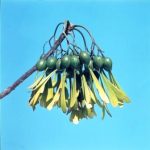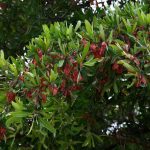TREE LIFE
NOVEMBER 1990
MASHONALAND CALENDAR
Tuesday 6th November: Botanic Garden Walk. Park your car at the Herbarium where we will meet Tom Muller at 1645 hours for 1700 hours.
Sunday 18th November: Outing to Sitra Pottery in the Bromley area. Something different this month. After looking at the trees at Gambier we will be shown around the pottery. This could be an opportunity to purchase some original gifts.
Saturday 24th November: Walk with Mark at Mukuvisi Woodland. Meet at the main car park by the office at 1500 hours. The exact site in the woodland to be determined.
MATABELELAND CALENDAR
Sunday 4th November: To Charles Stirling’s Mkondo Farm 46.5km out on the Victoria Falls Road. Meet at Falls Road Motors at 0830 hours or at the Blakes’ home in Glenville if you wish to condense lifts. Cars can be left under guard there.
MID NOVEMBER: Change of plan for Gwaai River as a film company has taken over the hotel at that time. We hope to go in mid-January when the weather is cooler and the trees should be in full leaf, discuss it at the next meeting.
Also change of plan for SUNDAY 2ND DECEMBER: To keep costs down we will revert to one long/one short outing every other month – also we got worried about mopane bees for December at Maleme. By courtesy of Mr. Graham Paxton we will go to ‘Sunrising’, one of Bulawayo’s stately homes owned by Anglo American Corporation. Morning only – bring tea and chairs.
Tuesday 1st January 1991: Our traditional New Year party with an ‘at home’ at the Blakes, telephone 62229, in Glenville from 1130 hours. The trees are waking up and if the river is running … it is a good area to work up an appetite.
p.s. Work is starting on an open-sided building at Richmond Nature Park and we have not finished identifying the trees there yet. Before it is opened to the public for those interested, a Saturday afternoon meeting has been arranged for 17th November. Meet at Falls Road Motors at 1430 hours. We will be visiting a beautiful spot next to the dam.
MATABELELAND NOTES
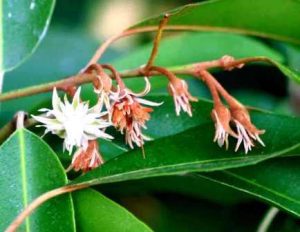
Mimusops zeyheri. Photo: Bart Wursten. Source: Flora of Zimbabwe
On Sunday 7th October we went to Hillside Dams, Upper Area, for a most successful Quiz. Full marks to the organisers! This was on the small kopje near the car park, which has a most interesting collection of trees dominated by a fine Mimusops zeyheri. There was sufficient leaf for good identification. We met at John Bishop’s house, as he is right on the spot and indeed had our tea there afterwards.
The main trees were Acacia rehmanniana, Celtis africana, Combretum molle, Commiphora mollis, Cussonia natalensis, Dombeya rotundifolia, Erythrina latissima, Euphorbia ingens, Flacourtia indica, Ficus glumosa, Grewia monticola, Kirkia acuminata, Mimusops zeyheri, Olea europea subsp. africana, Pappea capensis, Pseudolachnostylis maprouneifolia, Rhus lancea, Ozoroa insignis subsp. reticulata, Ximenia caffra, Ziziphus mucronata. There was also a fine pair of Dovyalis zeyheri in shiny new leaf and a number of interesting species in the surrounds. Results were pretty good.
Prize winners : First Group : Pam Brennan/Dennis Murray
Advanced Group : Thora Hartley/Joy Kets
-C.Sykes
BOTANIC GARDEN WALK – OCTOBER 1990
By popular vote, it was decided that we should look at Acacias again this month. A. schweinfurthii, A. ataxacantha and A. pentogona have scattered thorns. The only tree like Acacia with scattered thorns is A. eriocarpa, the first three being scramblers. The tree we looked at had no leaves, flowers or pods. It will be worth watching for the flower spikes (December-January) and its unusual pods – covered with dense brown hairs.
I took a Junior Science Club around the acacias a few days ago. They were to make a note of flower type and thorn type on each tree. I thought we would arrive at the flower spike/hooked thorn – pompom flower/straight thorn rule once we were back in the lab. Five minutes into the exercise I found myself being told airily “A. mellifera is the exception which proves the rule, man”. I made a rapid return to an A. mellifera to see if he was right!!! It does have curved prickles and ball type flowers in subsp. detinens/spikes in subsp. mellifera.
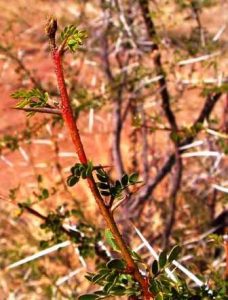
Acacia nebrownii. Photo: Rob Burrett. Source: Flora of Zimbabwe
I was wondering if I had mistaken young A. erioloba trees for A. nebrownii in Botswana recently, but was pleased to see that this had not been the case. The two species are flowering side by side in the Botanic garden, both with golden yellow balls, but A. nebrownii has fewer, larger leaflets. At the moment A. erioloba has bright red new shoots – they are zigzag in shape and so flexible that they almost seem to be made of plastic.
Another mystery laid to rest, was the identity of the semi recumbent acacia on the car park side of the dam. This is the candle pod acacia A. hebeclada subsp. chobiensis. It is in flower at the moment. In April when canoeing above Victoria Falls we passed these trees hanging low over the water, with fat green pods standing upright above the foliage.
Thanks Tom for doing acacias yet again – there is always something new to learn.
-Kim Damstra
MALABAR FARM, DARWENDALE
Carol and Les Harvey invited us to visit their farm on 16th September. The weather was very warm and young leaf and flowers showed that nature is moving into another year of growth and abundance.
Flowering along the way we noted Securidaca longipedunculata, the Violet Tree in full flower, this is a breath taking sight and one longs to have one in the garden. Unfortunately this tree is very difficult to establish. Transplanting does not work, and growing from seed is recommended only in situ – establishment in a pot or sleeve is encouraging but the young plants seldom survive when planted out.
Also flowering en route we noted Senna singueana, the Winter Cassia, or is it now Winter Senna, Cassia abbreviata, with young leaves and along the burnt roadside the glamorous spring collection of herbs, Gnidia kraussiana, Combretum platypetalum, Pentanisia schweinfurthii, Trichodesma phsysaloides, Gladiolus melleri, Hibiscus rhodanthus, and many more.
Appetites were whetted by the sight of large plots of Gazania, Mesembryanthemum and Morning Glory, but we turned off through the lands and spent a most entertaining morning along the bank of the Manyame River, led by Phil Haxen.
We found Bequaetiodendron magalismontanum flowering profusely along the stems of the old wood where eventually the fruits will form giving this species its common name which is Stem fruit. Salix mucronata was heavy in bud – male or female flowers, we wondered? – sexes grow on different trees.
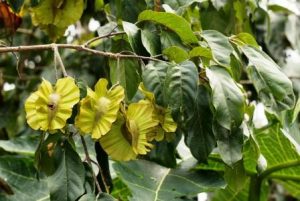
Combretum zeyheri. Photo: Bart Wursten. Source: Flora of Zimbabwe
Here grew Rhus quartiniana, the River Rhus, and Combretum erythrophyllum, the River Combretum, its many small, four winged fruits contrasting with the very large fruits of Combretum zeyheri, which grew nearby. Another interesting comparison was made when we found Faurea saligna, with a leaf very like Salix mucronata in appearance but with the tell tale sub marginal vein showing this genus to be different.
We left the bush and went to the homestead for lunch in the garden.
What can one say about the Harvey’s magnificent creation. We townies muttered about lots of water, plenty of labour, abundant fertiliser, but as we were shown around after lunch the truth could not be ignored. It was the imagination of Carol and Les that combined all these assets to take advantage of an attractive natural setting to create great splashes of colour in every direction. And, as all experts do, Carol made it all sound so easy.
Thank you Carol and Les for your hospitality and for creating a little plot of paradise for us all to share.
-E.R.R.H.
MAPERE FARM, BARWICK
The weather on 21st October was overcast and a little nippy, a real contrast to the previous Tuesday when the temperature had climbed to 35 degrees. However, our welcome from Kevin and Merle Grant brought sunshine back, and the very small party that had turned out went off to see what the kopje next to the homestead had to offer.
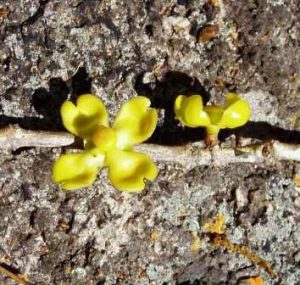
Garcinia buchananii. Photo: Mark Hyde Source: Flora of Zimbabwe
First to greet us was Osyris lanceolata, widespread but never abundant, the petioles of the alternate blue green leaves running down the stem to form slight ridges. Nearby we found Garcinia buchananii, an inhabitant of granite rocky areas with yellow sap visible when the leaves are broken in half. The fruit of Pittosporum viridiflorum had split open to reveal the bright red seeds, covered with sticky resin to assist dispersal by sticking to animals or birds that might venture near.
Great excitement ensued when we found Garcinia buchananii flowering. This genus often has different sexes on separate trees – the one we found had female flowers, and so life and limb were risked in an effort to find a tree with male ones.
A further exciting find was Apodytes dimidiata flowering. This tree has a most unusual black and scarlet fruit which looks enticing but is not edible – even the birds turn up their beaks at them.
The large, apparently occupied nest of a Hammerkop attracted a good deal of attention, indeed, the abundance of bird life was remarked upon by several members as a Heughlin’s Robin serenaded us while both Grey and Purple crested Lourie said in their own way “get out of my yard”
After lunch in our hostess’s lovely garden we wandered around there looking at the trees. It seemed a cruel thing to have to tell Merle that her banana tree with the enormous flower was doomed to die after the flowering had finished, but that is the way Nature wants it, and that’s the way its gonna be!
Our grateful thanks to Merle and Kevin for a most entertaining day.
-E.R.R.H.
MURANGA – The Great African Medicine Tree
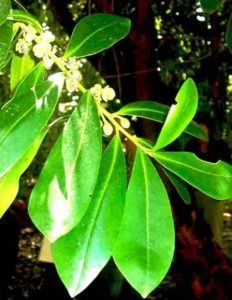
Warburgia salutaris. Photo: Mark Hyde. Source: Flora of Zimbabwe
Warburgia salutaris has a narrow range from Kenya to the Transvaal throughout which it is an endangered species. In Zimbabwe the only documented record was a small root sucker collected beside a dead trunk by Stephen Mavi in 1972 at Muhizo Hills near Tanganda.
The specific name salutaris means “healthy” or “salutary” in reference to its medicinal properties. This was once a fairly common tree, and is now rare because it is one of the great “muti” trees of Zimbabwe and as such it is systematically harvested by N’angas for its stem and root bark. The bark is used to treat almost any disease, including the “head” of a bewitched person. Fresh bark sold on local markets around Tanganda and Nyanyadzi is evidenced of the species occurrence, thereabouts, though it may be brought in from nearby Mozambique.
A study to establish the current status of muranga in Zimbabwe and to lay our conservation strategies is being carried out by the Forest Research Centre and the National Herbarium and Botanic Gardens. A recent tour of the Chipinge area revealed that the tree is now almost extinct. The local people know if its existence but cannot specify exact localities. The species is reported to be “protected” from the public by spirits. N’angas have declared “ownership” of the trees.
We found six seedlings in the Mhangura Mountains in the Chikore area, about 40km south east of Mount Selinda. The tallest was 60cm and the rest between 10and 20cm. It is uncertain whether these were grown by someone or naturally regenerated. Two seedlings were collected for propagation. Efforts to locate mature trees in the area were fruitless; only large holes from which trees had been excavated were seen. Our visit suggested that muranga is site specific and grows well on the southern aspects of steep slopes and cliff edges, on sources of mountain rivulets. It is a shy seed producer, one of the six trees, propagated from Mavi’s collection, in the Botanic Gardens produces well from air layering.
The species is vulnerable to over-exploitation as its bark brings in considerable income and measures to conserve it must be taken. Traditional conservation strategies must be reinforced. Muranga is a protected species and law enforcement by foresters and conservationists will slow down the rate of exploitation.
Forest Research News letter “Format” June 1990
CHIRINDA FOREST – Blake Goldsmith, Forestry Commission
I am going to paint a word picture of the lovely forest known s Chirinda. Incidentally, the word Chirinda means “A place of refuge”. Allegedly the local Ndau tribe hid in the forest when plundered by the renegade Chief Gngunyana, who was a Shangaan. Mount Selinda or Silinda is a corruption of Chirinda.
HISTORICAL AND GEOGRAPHICAL BACKGROUND
Chirinda is situated some 33km south of Chipinga near the Mozambique border. The total area of the sub-tropical or moist evergreen forest is 606 ha. All the land is administered by the Forestry Commission in addition to being a National Monument. Topography is mainly undulating, from a margin of 1060 m above sea level to two rounded peaks of 1220m elevation. Growing on a volcanic red dolerite outcrop the completely closed canopy is precisely defined, as can been seen on aerial photographs. The species and density of vegetation change abruptly where the dolerite gives way to sedimentary shales and quartzites of the Mkondo system. Again, this is clearly visible from the air as well as by ground inspection.
Rainfall is marginal and variable, ranging from 1100 – 2300 mm per annum. Much of the extra rain is derived from cyclonic activity in the Mozambique channel. Moisture laden south easterly winds boost the rainfall. The local mission station once registered 1400 mm in January alone. Drainage to all points of the compass finds its way into the Busi river and so to the Indian Ocean. The forest is damper and cooler than the surrounding tree veld, in addition to being warmer in winter.
Most people are agreed that Chirinda is relic forest of a bygone era. However, I cannot agree that the diminution of this type of vegetation has been brought about by man. It has enjoyed higher rainfall, and is climatically in a delicate balance today. Although many of the trees are rare or unknown in other parts of Zimbabwe/Rhodesia, none is truly endemic. Lovoa swynnertonii, the tall brown Mahogany, exemplifies this. It occurs in Kenya. Then there is a void before it is found in Chirinda and Mozambique. I have failed to find it anywhere else except in Chipete forest patch, which is a nearby satellite of Chirinda, also on dolerite. Neopalissya castaneifolia is a small gregarious tree with the appearance of a thornless lemon. This species occurs in Madagascar. What better evidence for Gondwanaland and the theory of Continental Drift. By comparison the Chimanimani mountain barrier of sugary quartzite supports endemic species because of its isolation.
A talk associated with Chirinda must include mention of Charles Francis Massy Swynnerton, Rhodesia’s greatest naturalist, who in his early twenties took up residence at Gungunyana farm, which has a part of Chirinda on it. He was born and educated in Britain but spent a short time with his clergyman father in India. He worked here for Sir Guy Marshall in the early quarter of the 1900’s. Marshall became a word renowned entomologist, particularly in the study of weevils. Swynnerton, a redhead, untrained but fired with the spark of curiosity, devoted himself to scientific study of the world about him. What better place than Chirinda.
This man collected fauna and flora assiduously under the most difficult conditions. Many plants, insects and animals bear his name, Swynnertonia cardineais a slender tall Asclepiadaceous twiner collected only twice in 70 years. Chirindia swynnertoni is a tiny pink worm like burrowing reptile removed by Swynnerton from a Kingfisher’s stomach. What a musical name for this little creature. It has only recently been re-collected in Mozambique. He walked to Beira and back at the beginning of the century, ostensibly on a tsetse fly survey. He was to become a world authority on tsetse fly and was the first Director of the East African Department of Tsetse Reclamation and Research. In 1938 he was awarded the C.M.G. for his work, but was tragically killed in a plane accident while on his way to Dar-es-Salaam with botanist companion B.D. Burtt, to receive the honour from the governor. Glossina swynnertoni is a tsetse fly of East Africa.
Swynnerton’s botanical trips into the Chimanimani are all too briefly described. This range, and Chirinda, must have seemed like an earthly paradise, despite the discomforts, so new were the many plants he collected. Some years back I met an African, Kositina, who was one of his six porters on the Beira trip. About 80 years old, he laughed when he recalled how they quickly ran out of food, and relied on friendly chiefs to help them.
I was privileged to meet Professor Phillips of “Oxbow” Tugela river fame. This ecologist was Swynnerton’s second in command at the time of his death. He had the unenviable task of finding the remains of the crash victims in thick bush. The Professor told me that Swynnerton was a poor administrator, so much so that his enforced resignation was only prevented at the eleventh hour by the Governor of the day, a wise man, who could see greatness in another who was a fellow of the Linnean Society. Swynnerton told the Professor that had he not married he could have devoted an even greater percentage of his time to his work. His wife must have been a lonely woman, but such was her lot in choosing a partner so unquestionably dedicated to his task. Swynnerton’s homestead is a delightful spot situated on the northern edge of the forest. Here one can see many exotic and indigenous species which he planted, and his plantation of two species of coffee. Three Camellia bushes flower profusely with enormous pure white blooms, more showy that the nearby red ones. At the Zona river the Scientific Association has erected a sandstone bench to commemorate Swynnerton. In this place is a profusion of two foot high perennial Thunbergia swynnertonii which bear pretty white or blue mauve flowers.
The Government took over Chirinda in the 1940’s. The farm Gungunyana was acquired with the Houtberg farm portion originally owned my Mr. Odendall, senior, who obtained it by Pioneer Title. His three sons exploited the brown and red Mahoganies and the beautiful, incomparable Chitonga wood, Strychnos mellodora. The Mission owned the best part, Chirinda. They had received a concession from Rhodes to fell 42m/3 of timber in the round per annum, for local use. It took only three trees to make up this large amount, so you can imagine what the long term effect would have been on the forest giants. It is to the credit of Mr. R. Hobbins, of the Forestry Commission that he had Rhodes’ concession terminated.
To be continued : from Zimbabwe Rhodesia Science News Vol. 14, No. 3 March 1980
DICK HICKS CHAIRMAN


